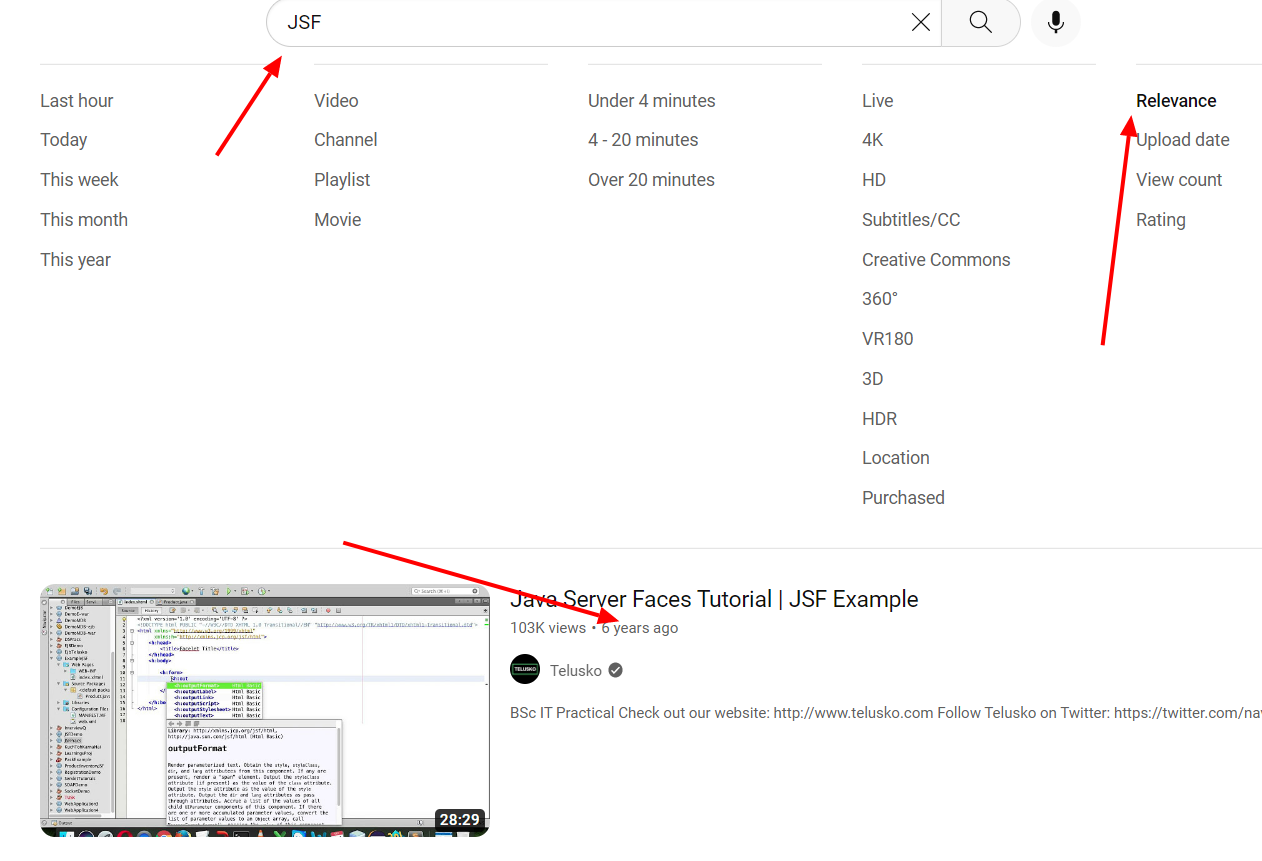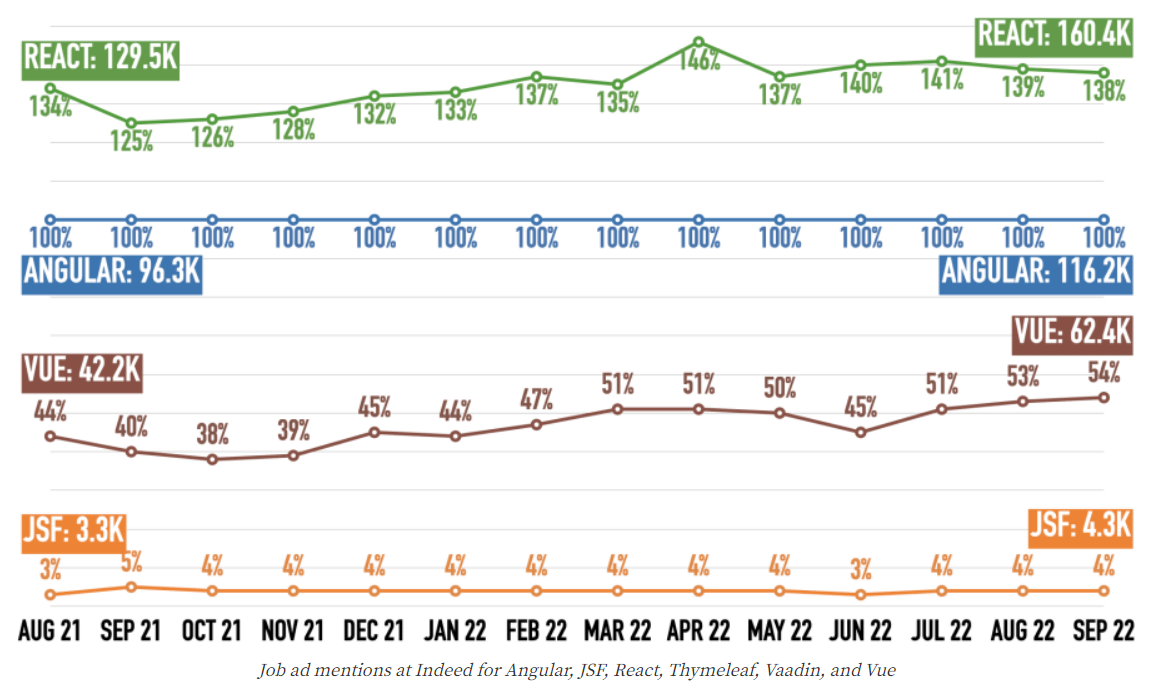The strong point for JSF is that your in-house or dedicated Java developers don’t need to know everything about frontend to do frontend stuff. However, over time, JSF projects become too complex to maintain, even if your team consists of 100% senior engineers. You're always days behind schedule when you require a use case that isn't provided with existing widgets/features. Developers are forced to create monstrosities of code trying to use JSF to work around the lack of some critical functionalities (like simple REST services). Switching from JSF to client-side frontend frameworks like Angular, React or Vue.js not only improves developer efficiency, state management, and testing - it’s also a clear step toward application modernization. You don’t have to migrate your entire JSF-based app at once: break your app down and modernize it in manageable pieces.
2025 Perspective: Angular Is Still Enterprise-Strong
"With giants like Google supporting it, Angular has built a solid reputation in enterprise software." — Medium, 2025
Even with forecasts of its decline, Angular remains a momentum in large-scale applications, proving that modernizing your front end remains a solid, long-term investment.
Angular not only modernizes your UI - but it’s also a proven, enterprise-grade framework backed by Google and powerful tools like Angular Universal.
Why Angular?
JSF is a server-side framework for building the front end of Java-based web applications. Angular is a client-side framework by default for building user interfaces of web applications with any backend including Java. Moreover, with tools such as Angular Universal, you can make Angular work as a server-side UI framework.
Angular is a widely-used framework and platform for building Single Page Applications (SPAs), developed and supported by Google. SPA web applications don't reload for each user's click. That's why such apps get positive user feedback and became mainstream in web building.
‘JSF has an overhead on the server side compared to JS frameworks like Angular. JSF needs to create a ViewRoot for each request for rendering, executing ajax events, and so on. That's much more CPU usage on the server side. I would always build web applications with JSF but nothing social, which expects millions of users a day. It better fits something like intranet, enterprise, backend applications.’
Thomas Andraschko, PrimeFaces Core Developer (25 Feb 2021)
JSF vs Angular: Architecture, Performance, and Maintainability
Compare the two based on architecture, developer experience, performance, and long-term support to determine if a modernization move makes sense.
| Aspect | JSF | Angular |
|---|---|---|
| Rendering | Supports partial updates via |
SPA architecture; default behavior includes dynamic content updates without page reloads |
| Architecture | Backend and frontend are tightly connected - adding features often needs workarounds | Frontend is separate from the backend. Built with reusable components that simplify updates and scaling |
| Developer Experience | Best for teams already deep in Java. UI logic is more difficult to write and test | Frontend developers enjoy familiar CLI tools, testing libraries, and workflow support |
| Performance | Heavy load on the server, especially when handling lots of views or users | Offloads rendering to client; reduces backend load and improves UI responsiveness |
| Maintainability | Harder to upgrade due to tight backend coupling and dependency on full-stack Java knowledge | Easier to maintain; UI is decoupled from backend and follows modern web standards |
| Community & Ecosystem (2025) | Fewer updates and a smaller community. Most new Java apps are built with other tools | Still actively maintained by Google. Strong community and rich ecosystem of libraries and tools |
| Best Fit For | Internal enterprise tools that won’t change much or don’t need flashy UIs | Ideal for modern web apps, high-interaction dashboards, and systems that require scalability and long-term support |
Is JSF obsoleted?
“A Look Back: JSF use has waned over the years as robust JavaScript frameworks have arisen.” — William Corrie, Principal Architect at CareCentrix, LinkedIn, Apr 2025

The last "relevant" tutorial at Youtube on JSF was released years ago...
Numerous complaints about JSF are mostly related to old versions and some of them are now outdated. However, companies may still use JSF 1.0, first realized 15 years ago (or, at best, JSF 2.0) with a lot of ad-hoc programming.
As Arjan Tijms, a project lead for JSF, stated in his article on Oracle blog Java for the enterprise: What to expect in Jakarta EE 10:
"The next version of JSF will be JSF 4.0. Its own major theme will be removing legacy functionality that has already been deprecated. Plus, legacy features that haven’t been deprecated before will be deprecated and likely removed in a future release. Support for Jakarta Server Pages (JSP) as a view declaration language will be removed as well. As for bigger features, a prototype is currently in the works to add a simple REST lifecycle to JSF. This is not intended as a full-featured REST framework."
Rollbar’s 2025 analysis confirms JSF no longer ranks among the top Java web frameworks - most enterprise projects now favor Spring, Quarkus, or Micronaut.
In this regard, migration is absolutely necessary whether it will be to a newer JSF version or to another UI framework for Java web applications.
The question is when to do this: if not today, it may be more costly to make it tomorrow if you plan to improve your software application.

betterprojectsfaster.com/guide/java-full-stack-report-2022-12/fe-web/

Ihatejsf.com, a platform to share the frustrations with using JSF.
Framework Migration
"Framework migrations are significant undertakings; carefully evaluate your team's requirements and long‑term maintenance needs before committing." — Rollbar, 2025
Moving from JSF to Angular isn’t just a tech swap, it’s a strategic move. You’ll need clear goals, stakeholder alignment, and a phased migration plan to ensure success.
Planning a phased JSF-to-Angular migration? Our team can audit your current UI stack analyzing performance bottlenecks, developer efficiency, and UX and deliver a clear, phased modernization plan aligned to your goals. Talk to our experts.
Rate this article
Recommended posts
Portfolio
Our Clients' Feedback


















.jpg)
.jpg)
.jpg)
.jpg)

















We have been working for over 10 years and they have become our long-term technology partner. Any software development, programming, or design needs we have had, Belitsoft company has always been able to handle this for us.
Founder from ZensAI (Microsoft)/ formerly Elearningforce